Seminole Wars Authority
The Seminole Wars Authority podcast looks at Seminole resistance to the United States’ campaign of Indian removal in the 1800s. We explore what the Seminole Wars were, how they came to be, how they were fought, and how they still resonate some two centuries later. We talk with historians, archaeologists, anthropologists, archivists, writers, novelists, artists, musicians, exhibitors, craftsmen, educations, park rangers, military-era reenactors, living historians, and, to the descendants of the Florida and Oklahoma Seminole who fought tenaciously to avoid US government forced removal. Host Patrick Swan is a board member with the Seminole Wars Foundation. This podcast is recorded at the homestead of the Seminole Wars Foundation -- www.seminolewars.us -- in Bushnell, Fla. Subscribe automatically to the Seminole Wars Authority through your favorite podcast catcher. (Banner photo by Andrew Foster)
Episodes
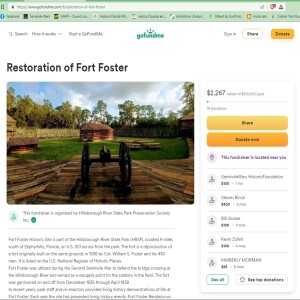
Tuesday May 09, 2023
Tuesday May 09, 2023
Twenty volunteers entered the shuttered Fort Foster at Hillsboro River State Park May 6. They ripped out rotten planks from a boardwalk encompassing the inside of the palisade walls confines. This brings the replica post one step closer to re-opening when state officials re-certify it is safe to the public to do so.
In this episode, Louie Bears Heart, a living historian portraying a Seminole of the period, witnessed the operation and joins with his observations and assessment. But first, some background on the fort.
Fort Foster Historic Site is part of the Hillsborough River State Park (HRSP), located 9 miles south of Zephyrhills, Florida, on U.S. 301 across from the park. The fort is a reproduction of a fort originally built on the same grounds in 1836 by Col. William S. Foster and his 430 men. It is listed on the U.S. National Register of Historic Places.
Fort Foster was utilized during the Second Seminole War to defend the bridge crossing at the Hillsborough River and served as a resupply point for the soldiers in the field. The fort was garrisoned on and off from December 1836 through April 1838
In recent years, park staff and re-enactors provided living history demonstrations of life at Fort Foster. Each year the site has presented living history events: Fort Foster Rendezvous in January and the Candlelight Dinner experience at Fort Foster during the winter months. The park staff has also conducted weekly tours of the park, allowing visitors the opportunity of touring the fort and grounds.
The HRSP Preservation Society set up a site for citizen donations to cover restructuring costs. https://www.gofundme.com/f/restoration-of-fort-foster Hillsborough River State Park Preservation Society Inc. is a volunteer citizen support organization founded in 1993 to support the needs of Hillsborough River State Park and Fort Foster Historic Site. For more information on them and to contact, go to http://www.historyandnature.org/ and contact@historyandnature.org
Hillsborough River State Park’s Fort Foster Rendezvous is a living history reenactment featuring military, Seminole, and civilian re-enactors, sutlers, traders, and craft demonstrations of the time during the Second Seminole War (1835-1842) in Florida.
Host Patrick Swan is a board member with the Seminole Wars Foundation. This podcast is recorded at the homestead of the Seminole Wars Foundation in Bushnell, Fla.
Subscribe automatically to the Seminole Wars through your favorite podcast catcher and "like" us on Facebook, LinkedIn, and YouTube!

Sunday Apr 30, 2023
Sunday Apr 30, 2023
In our last episode, we reviewed how three years of the Seminole Wars Authority podcast have told the story of Seminole resistance to U.S. Government removal efforts. In this episode, we place the podcast in the context of the Foundation’s Frank Laumer Library for Seminole Wars Studies, the Laumer Library for short. We will discuss the themes presented – Black Seminoles, Crackers, Soldiers, Seminoles – among the collection’s two thousand five hundred titles. We also investigate opportunities for scholars and students scouring these shelves and among the several filing cabinets of Frank Laumer’s primary-source research materials.
Seminole Wars Foundation President, Steve Rinck, once again takes hosting duties to interview Patrick Swan, caretaker for the Laumer Library as well as our regular host.
This podcast is recorded at the homestead of the Seminole Wars Foundation in Bushnell, Fla.
Subscribe automatically to the Seminole Wars Authority through your favorite podcast catcher and "like" us on Facebook, LinkedIn, and YouTube!
The Seminole Wars Foundation houses 2,500 titles in book, magazine, and journal form, plus thousands of digital images and scans of key Seminole Wars documents and living history event activities.
Researchers can conduct high resolution scans of 1800s art and illustrations (above) pulled from the library shelves or the filing cabinets (below) at the Center.
Awaiting patrons are roughly 300 novels, from the 1830s to the present, all related in some way to the Seminole, Crackers, and Seminole Wars. This fiction ranges from wholesome to pulp and everything in between.
One can see a selection of themes on the shelves, from Black Seminoles to War, to Firearms, to Osceola, again and everything in between.
The Seminole Wars Foundation has a book store with popular Seminole Wars titles (above) and features a host of Seminole Wars-related cultural ephemera to view (below).
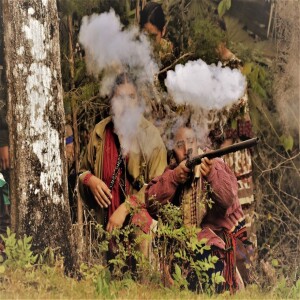
Monday Apr 24, 2023
Monday Apr 24, 2023
This episode marks an anniversary for the podcast: Three full years’ worth of the Seminole Wars Authority.
We have done as we said we would do when we set out on this long march. We canvassed far and wide for authorities in possession of the knowledge about the Seminole Wars. Some are historians, John Missall and Jesse Marshall and Chris Kimball. Some are professors, Dr. Jim Cusick and Dr. Joe Knetsch, among many others. Some are artists, such as Johnny Montgomery and Jackson Walker. Some are just self-described regular guys with an interest in living history presentations of this conflict, fellows such as citizen-scholar Jeff Snively and truck driver and surveyor Jerry Morris. Oh yes, we’ve also interviewed a long list of re-enactors – never call it cosplay, if you value your life. All have something interesting to say and meaningful to contribute to the conversation. Chris Kimball, whom along with Jesse Marshall knows everything, understands everything, and recalls everything about the Seminole Wars tells me he always learns something new and useful from listening to a Seminole Wars podcast. That’s a gold medal to my chest.
Steve Rinck, Seminole Wars Foundation president, helms this episode with longtime host Patrick Swan.
This podcast is recorded at the homestead of the Seminole Wars Foundation in Bushnell, Fla.
Subscribe automatically to the Seminole Wars Authority through your favorite podcast catcher and "like" us on Facebook, LinkedIn, and YouTube!
Above, Andrew Foster icon image used for first two years on the Seminole Wars podbean splash page. Podcast Mission Control.
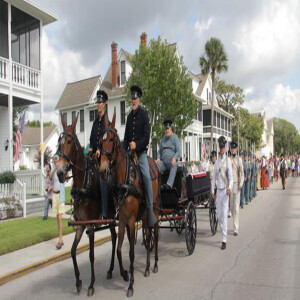
Sunday Apr 16, 2023
Sunday Apr 16, 2023
In the middle of August each year at St. Francis Barracks in St. Augustine, two elegant mules pull a caisson symbolically carrying the remains of the soldiers who had died in the Second Seminole War.
The procession they lead commemorates the first re-interment of soldiers in Aug. 15, 1842. The commanding officer in charge of military operations in Florida, U.S. Army Col. William Worth, declared an end to hostilities and called for the remains of the fallen to be gathered together and transported to St. Augustine. He detailed that the caissons be pulled by Elegant Mules.
Emmitt and Tater are the two mules with whom Thomas F. and Denise Fitzgerald provide to offer “solemn pride” for fallen military veterans today.
In this episode, Tom Fitzgerald joins us to discuss what he and his wife do for deceased veterans as well as everything you might want to know about caring for two elegant mules who lead funeral processions.
Denise and Tom Fitzgerald take great care to ensure their presentation honors the fallen to the utmost. Courtesy photos from Andrew Foster and Tom Fitzgerald.
Host Patrick Swan is a board member with the Seminole Wars Foundation. This podcast is recorded at the homestead of the Seminole Wars Foundation in Bushnell, Fla.
Subscribe automatically to the Seminole Wars Authority through your favorite podcast catcher and "like" us on Facebook, LinkedIn, and YouTube!
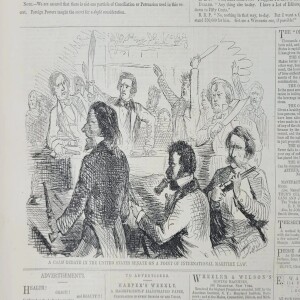
Sunday Apr 09, 2023
SW0155 SemWar Newspapers Printed Congressional Debates, Art (2 of 2)
Sunday Apr 09, 2023
Sunday Apr 09, 2023
In our previous episode, Jesse Marshall gave listeners an overview of newspaper coverage of the Seminole Wars, reviewing their accuracy given the physical and technical constraints of the era. In this episode, Jesse relates the value of these newspapers’ accounts for informing the American public about what actions and activities their government engaged in on their behalf in the Seminole Wars.
Jesse lays out a mixed bag: some newspaper articles offered first-hand accounts of battle that hold up surprisingly well as part of the historical record. Others conveyed the gist of a battle but were wildly inaccurate about casualty details. Jesse explains how historians collate such reports -- often using reprints from the congressional record -- to attempt to arrive at an accurate assessment of what happened in a given encounter. In addition, printer capabilities improved to run woodcut illustrations, thereby presenting images, some accurate, some fanciful about the war.
Newspapers often often full congressional debates about the war and, when the technology permitted, illustrations of the contentious points being debated.
Late in the 3rd Seminole Wars period, printer technology advanced to the state where Harper's Weekly could run a spread illustrating Billy Bowlegs' story through text and art. Frank Leslie's Illustrated Weekly brought consistent images to its readers, but began too late for the Seminole Wars.
Chris Kimball presents an index to Seminole War Articles in the Army-Navy Chronicle. Below, David Fowler present full articles, in edition to an index, for war coverage in the Nile's Weekly Register, a national newspaper of the time.
Host Patrick Swan is a board member with the Seminole Wars Foundation. This podcast is recorded at the homestead of the Seminole Wars Foundation in Bushnell, Fla.
Subscribe automatically to the Seminole Wars Authority through your favorite podcast catcher and "like" us on Facebook, LinkedIn, and YouTube!
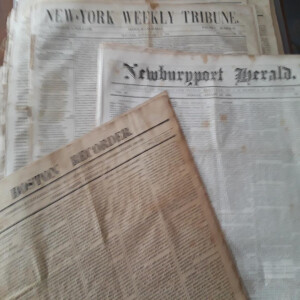
Sunday Apr 09, 2023
SW0154 SemWar Coverage Ebbs and Flows in Era Newspapers (1 of 2)
Sunday Apr 09, 2023
Sunday Apr 09, 2023
A popular conceit for a newspaper is that it is the purported “first draft of a history.” Newspapers informed the public. But they also tended to reflect the public’s opinion. And that opinion for waging the Seminole Wars waned overtime, as did newspaper coverage.
How did local and national newspapers present the Seminole Wars in print? Was the war always front-page news? How did the war’s placement compare to other events of its time? What did newspapers get right in what they reported from the field of battle and the fog of war? And what constrained newspapers from offering a fuller treatment of the war? How did the war’s placement compare to other events of its time?
In the first of a two-part episode, Jesse Marshall returns to the Authority. He has reviewed a stack of 19th century newspapers from the Seminole Wars Foundation’s archives and assesses how much of their war reporting has stood the test of time.
Before an improvement in printing technology allowed for regular use of printed illustrations, newspapers until the 1940s were relatively drab in layout. Text alone conveyed the news.
One could follow the war in the newspapers, if one read carefully.
Newspapers listed military officer assignments and ran editorials and letters to the editor for -- and below, against -- the Florida war. They also sold ads for returning runaway slaves to their owners as well as various sundry items.
Some websites let researchers read thousands of U.S. newspapers online.
Host Patrick Swan is a board member with the Seminole Wars Foundation. This podcast is recorded at the homestead of the Seminole Wars Foundation in Bushnell, Fla.
Subscribe automatically to the Seminole Wars Authority through your favorite podcast catcher and "like" us on Facebook, LinkedIn, and YouTube!
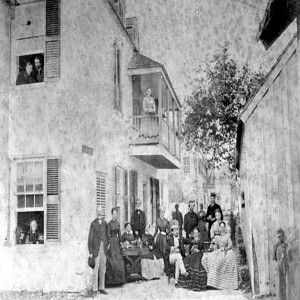
Wednesday Mar 29, 2023
Wednesday Mar 29, 2023
In 1812, during the East Florida Patriot War incursion against Spanish territorial rule, 15-year-old Louisa Fatio barely escaped when Seminole attacked and partially burned her family's beautiful New Switzerland plantation on the St. Johns River. Louisa was the granddaughter of Francis Philip Fatio, co-founder and later sole owner of the 10,000-acre New Switzerland plantation, west of St. Augustine.
Frantically searching for safety throughout the wilderness of Florida, her family first endured the bloody Patriots’ War only to see their new house destroyed by a hurricane. Next, they sought haven in Fernandina until invading pirates burned that property to the ground. Fleeing once more, the Fatios returned and rebuilt New Switzerland Plantation between 1822 and 1824, where Louisa becomes its charming hostess.
The New Switzerland plantation was torched a second time by Seminole during the Second Seminole War, which began in 1835. The next year, 1836, Louisa Fatio moved to St. Augustine, where she remained for the rest of her life. The city was filled with military personnel and refugees from the war, and she found work managing boarding houses with her sister Eliza. There, she used her keen business sense and hospitality to create a career as an innkeeper - one of the few respectable occupations available to a woman of her standing in her day.
Under her management, the house on Aviles Street became known as Miss Fatio's. Soon Miss Fatio’s lovely and famous boarding house began to offer the best lodging and the finest table in tropical Florida. The establishment was a fixture in St. Augustine until her death in 1875.
Louisa Fatio is the subject of a one-woman performance by Florida thespian, Dianne Thompson Jacoby. In this episode, Dianne slips into her impression of Louisa to tell the story of East Florida in the St. Augustine vicinity during the Seminole Wars period.
Host Patrick Swan is a board member with the Seminole Wars Foundation. This podcast is recorded at the homestead of the Seminole Wars Foundation in Bushnell, Fla.
Subscribe automatically to the Seminole Wars Authority through your favorite podcast catcher and "like" us on Facebook, LinkedIn, and YouTube!
Louisa Fatio (in first floor window) with guests at her St. Augustine boarding house. Below, an artist rendering of a younger Louisa.
She managed New Switzerland Plantation, where she was born, after her father died.
St. Augustine thespian Dianne Thompson Jacoby portrays Louisa Fatio in one-woman performances around Florida. Photo screen capture courtesy St. Augustine Record.
Dianne Thompson Jacoby also portrays a Cracker lady, Martha Jane, at various venues. Martha Jane makes an uncredited visit in this episode.
One can learn more about Diane and the characters she portrays by visiting her webpage at www.mrsflagler.weebly.com or by her Facebook page: Diane Thompson Jacoby.
She performs with Double Trouble Theatre Company.
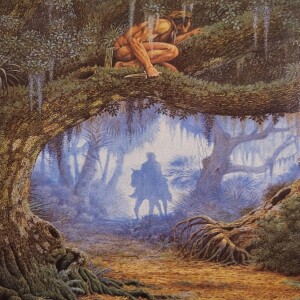
Sunday Mar 19, 2023
Sunday Mar 19, 2023
A soldier of the Second Seminole War would have led an austere life at remote Army outposts in Florida. Among the few pleasures in his life might have been playing with a deck or cards or dice and getting square meals. What might have had the greatest impact on his morale, however, was the ability to receive and send mail to loved ones back home.
If he was stationed at Fort King, near present day Ocala, he might have sent his personal mail through the nearby Seminole Agency post office. How did it travel from there? Turns out, there was an intricate operation behind the postage for a soldier’s letter. In this episode, we’ll find out just how they did it.
Thomas Lera, a director of the Florida Postal Society, researches postal history from throughout the state of Florida. Postal history collects the envelopes, the history of the envelopes used, and the stamps and markings placed on them. Tom is co-editor of the book, Florida Postal History, 1763-1861. In researching that book, he discovered the Seminole Agency. Given its prominence in the era of Seminole removal, Tom decided to explore it it in more depth.
The Seminole Agency was based in Alachua County near Fort King, on the main military and post road connecting Micanopy and Tampa Bay. In August 1835, U.S. Army Private Kinsley Dalton, mail courier between Fort Brooke and Fort King, fell victim to a Seminole retaliatory attack. The Army continued to send mail, however, either on the Fort King road or via other trails or the sea around the Florida Peninsula.
The Agency’s House was positioned on the northern edge of the reservation. The house included a scaled floor plan and frontal view. The building was spacious at over sixty feet square. It included four large meeting rooms, wide hallways, and large porches.
All Charts courtesy Tom Lera
Host Patrick Swan is a board member with the Seminole Wars Foundation. This podcast is recorded at the homestead of the Seminole Wars Foundation in Bushnell, Fla.
Subscribe automatically to the Seminole Wars Authority through your favorite podcast catcher and "like" us on Facebook, LinkedIn, and YouTube!
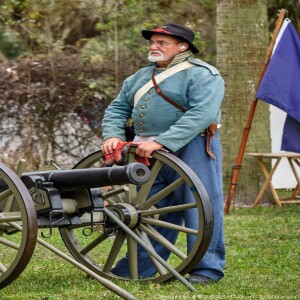
Tuesday Mar 14, 2023
SW0151 Navy Vet Personifies Fort Pierce’s Most Worthy Commander
Tuesday Mar 14, 2023
Tuesday Mar 14, 2023
Listeners to this podcast already know that Fort Pierce is a reservation for the Seminole Tribe of Florida. Previously, guest Rollie Gilliam told us about its origins as a home for Black Seminole. In this episode, living historian Jim O’Dell joins us to describe the military origins of Fort Pierce, his hometown.
A U.S. Navy veteran, Jim stepped into the part of playing U.S. Army Brevet Lieutenant Colonel Benjamin Pierce to present public impressions of the fort’s namesake and first commander during the Second Seminole War. What role did Fort Pierce play in the war? Who were its later famous commanders? And what became of the troops’ payroll in gold that was lost when the schooner carrying the paymaster sank near the fort’s inlet. We’ll find out.
U.S. Navy veteran Jim O'Dell portrays Brevet Lt. Col. Benjamin Pierce at living history events. He stands here with his six-pound cannon, King David.
Jim O'Dell, Dowling Watford, and Jim Flaherty portray soldiers from Second Seminole War. Courtesy photo by Allen. Below, Jim O'Dell and his friend from Okeechobee, Dowling Watford, moving out to battle.
Jim O'Dell related the story of this shipwreck in his discussion. Below, the plot for Fort Pierce still exists. The fort itself is in St Lucie's County, Fla.
Host Patrick Swan is a board member with the Seminole Wars Foundation. This podcast is recorded at the homestead of the Seminole Wars Foundation in Bushnell, Fla.
Subscribe automatically to the Seminole Wars Authority through your favorite podcast catcher and "like" us on Facebook, LinkedIn, and YouTube!
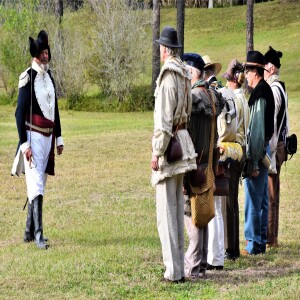
Monday Mar 06, 2023
Monday Mar 06, 2023
The annual Fort Cooper Days battle commemoration returns March 18 and 19 at Fort Cooper State Park in Inverness. This battle featured militia and volunteers fighting off a Seminole attack in the second of those wars.
A militia captain, rising from the ranks of private to sergeant and then officer, is Howard “Butch” Nipper Junior. He is a proud third generation Florida Cracker and he portrays a Florida Cracker who picks up his musket and answers the call of duty to muster. Butch tell us all about a militiaman’s life in the Second Seminole War and how modern living historians present impressions to educate, inform, and entertain the public.
Butch Nipper command a small squad during a demonstration at the Florida Pioneer Museum in Dade City, Fla. He then joins with Matt Milnes, who portrays a regular Army officer, in calling for the men to fire a salute.
Butch Nipper's parade dress is based on the Uniform of the Macon Volunteers, which served with Major Cooper's 1st Battalion of Georgia Foot in Florida in 1836. Daguerreotype circa 1845. Below, illustration of a militia officer commanding the unruly militia at a muster.
Host Patrick Swan is a board member with the Seminole Wars Foundation. This podcast is recorded at the homestead of the Seminole Wars Foundation in Bushnell, Fla.
Subscribe automatically to the Seminole Wars through your favorite podcast catcher and "like" us on Facebook, LinkedIn, and YouTube!





